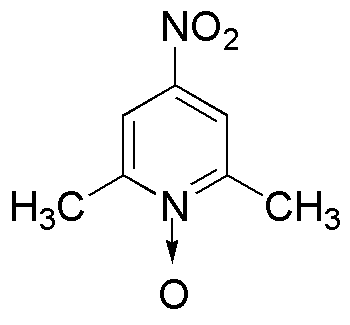2,6-Dichloro-4-nitropyridine N-oxide is widely utilized in research focused on:
- Agricultural Chemistry: This compound serves as an effective herbicide, helping to control unwanted plant growth in various crops, thereby improving yield and reducing competition for resources.
- Pharmaceutical Development: It is used as an intermediate in the synthesis of pharmaceuticals, particularly in developing compounds that target specific biological pathways, enhancing drug efficacy.
- Material Science: The compound finds applications in the development of specialty polymers and coatings, offering improved durability and resistance to environmental degradation.
- Analytical Chemistry: It acts as a reagent in various analytical techniques, aiding in the detection and quantification of other chemical substances, which is crucial for quality control in manufacturing.
- Environmental Monitoring: This chemical is utilized in studies assessing the impact of pollutants, helping researchers understand and mitigate environmental risks associated with agricultural practices.
Informations générales
Propriétés
Sécurité et réglementation
Applications
2,6-Dichloro-4-nitropyridine N-oxide is widely utilized in research focused on:
- Agricultural Chemistry: This compound serves as an effective herbicide, helping to control unwanted plant growth in various crops, thereby improving yield and reducing competition for resources.
- Pharmaceutical Development: It is used as an intermediate in the synthesis of pharmaceuticals, particularly in developing compounds that target specific biological pathways, enhancing drug efficacy.
- Material Science: The compound finds applications in the development of specialty polymers and coatings, offering improved durability and resistance to environmental degradation.
- Analytical Chemistry: It acts as a reagent in various analytical techniques, aiding in the detection and quantification of other chemical substances, which is crucial for quality control in manufacturing.
- Environmental Monitoring: This chemical is utilized in studies assessing the impact of pollutants, helping researchers understand and mitigate environmental risks associated with agricultural practices.
Documents
Fiches de données de sécurité (FDS)
La FDS fournit des informations de sécurité complètes sur la manipulation, le stockage et l’élimination du produit.
Spécifications du produit (PS)
Le PS fournit une description complète des propriétés du produit, notamment sa composition chimique, son état physique, sa pureté et les exigences de stockage. Il détaille également les plages de qualité acceptables et les applications prévues du produit.
Certificats d'analyse (COA)
Recherchez des certificats d'analyse (COA) en saisissant le numéro de lot du produit. Les numéros de lot et de lot se trouvent sur l'étiquette d'un produit, après les mots « Lot » ou « Lot de fabrication ».
Numéro de catalogue
Numéro de lot/série
Certificats d'origine (COO)
Ce certificat d'exploitation confirme le pays dans lequel le produit a été fabriqué, et détaille également les matériaux et composants utilisés et s'il est issu de sources naturelles, synthétiques ou autres sources spécifiques. Ce certificat peut être requis pour les douanes, le commerce et la conformité réglementaire.
Numéro de catalogue
Numéro de lot/série
Fiches de données de sécurité (FDS)
La FDS fournit des informations de sécurité complètes sur la manipulation, le stockage et l’élimination du produit.
DownloadSpécifications du produit (PS)
Le PS fournit une description complète des propriétés du produit, notamment sa composition chimique, son état physique, sa pureté et les exigences de stockage. Il détaille également les plages de qualité acceptables et les applications prévues du produit.
DownloadCertificats d'analyse (COA)
Recherchez des certificats d'analyse (COA) en saisissant le numéro de lot du produit. Les numéros de lot et de lot se trouvent sur l'étiquette d'un produit, après les mots « Lot » ou « Lot de fabrication ».
Numéro de catalogue
Numéro de lot/série
Certificats d'origine (COO)
Ce certificat d'exploitation confirme le pays dans lequel le produit a été fabriqué, et détaille également les matériaux et composants utilisés et s'il est issu de sources naturelles, synthétiques ou autres sources spécifiques. Ce certificat peut être requis pour les douanes, le commerce et la conformité réglementaire.


